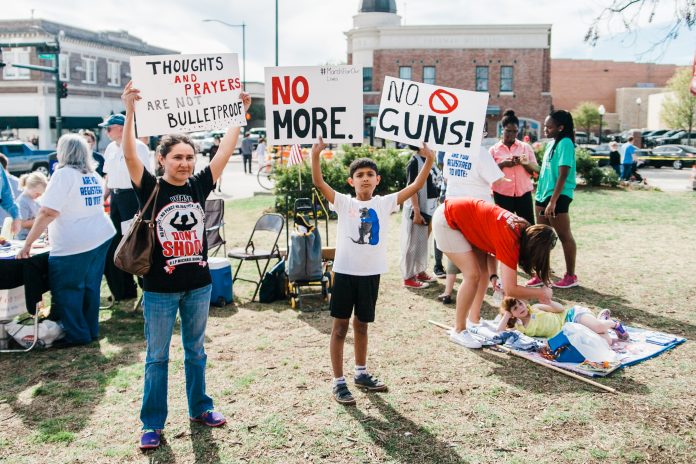Random and extreme violence, mostly committed by disturbed individuals with access to guns and other weaponry (such as fast moving vehicles), has become epidemic in America.
In just the last few days these angry and disturbed individuals have killed innocent bystanders in California, Ohio and Texas and little has really been accomplished legislatively to stop them in their tracks.
As we know from the headlines, any place people gather in fairly large numbers seems to be the preferred target of people bent on homicidal acts. These include schools, churches, bars, concert gatherings, public squares etc.
Short of a complete ban on (and confiscation of) assault weapons, magazine-enhanced pistols and other weapons of literal mass destruction, nothing much is likely to change anytime soon. The Second Amendment of the U.S. Constitution codified the “right to bear arms” and, though it was written in a time of single loading muskets that could do little mass harm, its defenders are resolute and unwavering even in the face of the anarchy and anguish irresponsible high tech gun ownership is enabling.
A relatively safe-from-random-violence America is a standard that must be encouraged or we will continue to lose respect in comparison to other developed countries.
Think Canada, our northern neighbor. Canada bans 15 types of assault weapons, greatly discouraging their access to the general public. In one recent year only 1.7 murders per 100,000 people occurred in Canada compared to the U.S.’s 4.7 murders per 100,000. And between 1982–2013 there were only TWO shootings in Canada involving six people or more compared to the U.S.’s 45. (Source: americanada.us, my 2017 book on U.S./Canada relations).
Of course, Canada has one tenth the population of the United States. But clearly Canadians, despite legal gun ownership, have fewer instances of extreme violence not only because of inaccessibility to high powered weapons but because they are, as a people, simply more civil and restrained. (Maybe it is their British character — even though the country has embraced immigrants from all over the world in recent years). They also get more training in the proper use of the weapons they have.
It is little wonder that Americans, despite being woefully ignorant about Canadians’ history, politics, demographics etc., continue to admire them — and feel safe traveling within their provinces.
But back to the realistic present. What can you do in the current atmosphere of inaction by politicians — and confusion by the general public — to avoid becoming a victim of random and extreme violence? And what can you do to possibly help prevent it from happening to others?
Below are examples although they are, of course, not one-size-fits-all.
(1) Practice Concentrated Awareness of Your Surroundings at All Times
Since violence can occur anywhere, you must avoid “letting your guard down.” Constant paranoia about what COULD occur is not suggested here, but a healthy distrust of strangers is paramount. When traveling on public transit, shopping in stores, or walking/running in public places you should keep your eye out for people who do not seem to fit in and are acting differently than others. We can all be lulled into the safety of our homes, neighborhoods and work places and forget that danger lurks everywhere. As a child I was threatened with a sexual act by an adult after school on a playground. I still remember the terror I experienced until I managed to get home before he apprehended me. I should not have been on that playground alone.
(2) Avoid Gatherings of People in Public Places Unless Security Is Around
This is obviously a bitter pill because some of the most enjoyable people activities involve being in large groups, such as at concerts, fairs, political gatherings etc. But is there security in place? The mass killers know they can be anonymous in a crowd, maim the most people when there is density, and get away with their wicked deeds before most even know what is happening. If they are aware of security (armed guards, police officers etc. in attendance) they will probably choose another venue or change their minds (one hopes). So always verify that security is in place, the numbers, and what type it is. THEN have the fun you came there for.
(3) Arm Yourself with Non-lethal Strategies for Warding Off Attacks
Everyone should be able to defend themselves in a variety of ways. Everyone having guns is NOT the answer, though such an argument is generally heard from NRA members. The availability of guns has made trauma cases in hospitals extremely difficult to deal with because guns pack so much ballistic power. Self defense using a gun might be effective but it could also be lethal and lead to a murder charge. (OR you could misfire and injure yourself.) Your goal should be to disarm an attacker in some way so as to, ideally, not kill him/her. Carrying pepper spray is one such defense. Having knowledge of self-defense tactics like karate will give you confidence that you can disable an attacker long enough to escape. Carrying a knife and revealing it might be enough to ward off an attack. As a young man I foolishly hitchhiked across the entire U.S. and got picked up by a group of men in a truck who let me out, then decided to “rush” me — when I revealed the knife I was carrying, they got back in the vehicle and left.
(4) Enroll your Children in Schools that Have “Hardened” Their Responses to Attacks
Schools are under pressure to have more security on staff but also to have technologies that allow quick communications in the event of an outside attacker somehow getting onto the school grounds. Before you enroll your children in school you should have a chat with a counselor or principal about just what they have done or are doing to protect their students. (Arming teachers is generally not considered a sensible solution.) I recently visited my granddaughter’s elementary school in Oregon, and before we were allowed anywhere near the kids we had to sign in, reveal our connections to the student(s), wear identifying badges and be guided to the common areas. But of course an attacker would likely just barge in, and there needs to be an immediate response mechanism to disable him before other authorities reach the scene and take over. Even pepper spray would be better than nothing.
(5) Practice Civility Wherever You Go and Restrain from Confronting Others’ Beliefs
It is the author’s feeling that our country is becoming less civil and that this has been developing for many years. There is, of course, all forms of road rage. Political divisions alienate friends and even marriage partners. Racial intolerance is nothing new but much of it focuses today on so-called illegal “aliens.” (Many of the shooters have some kind of axe to grind and feel powerless without being able to draw attention to it — via a weapon, which is a guaranteed way —even if it means self destruction). We all need to respect others’ opinions and not be quick to judge. Unfortunately, we have a current president who insists on creating divisions through his casual tweets, uncurated public statements and hostility to civil public discourse in general. We need to really listen to our fellow citizens and not be tempted to antagonize. America is all about diversity, and working out our differences together.
(6) Relocate to Areas Where Violent Crime Rates are Statistically Minimal
This is kind of a “cop out” solution but if you want to find historically safe areas to move to (and I must admit I ran a business for years, the Greener Pastures Institute, that asisted in this), the data is there. Of course, before the shootings in Thousand Oaks, California, it was considered one of the safest small cities in California. (Which just goes to show how there are damn lies and statistics, as Mark Twain once observed.) However, statistics don’t always lie, and you can play the odds better if you live in a place that hasn’t had recent acts of extreme violence. (By this measure, even Sandy Hook qualifies). If you’re of retirement age, a planned retirement community makes sense as most “elders” are not prone to impulsive acts. Small towns in general (and I wrote the book on how to move to them) are safer because more people know each other, and the dynamic of small towns is that problems can be solved on a more individual scale. (But, of course, there is always room for the local feud.) In my town of Cambria, CA, we have Nextdoor.com, a kind of downhome bulletin board and chatroom where people can vent about issues, or just stay in touch with neighbors as desired.
In Conclusion
Until lawmakers come to their senses and realize that extreme violence is usually enabled by ballistic weapons — some of which need to be banned or severely restricted (and others need to be outright confiscated, such as assault weapons) — people will remain vulnerable throughout America.
In the meantime, we have a personal responsibility to protect ourselves and our children in ways that are sensible. I hope my suggestions have value and lead to further discussion and debate.
Image Credit


























